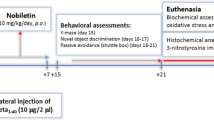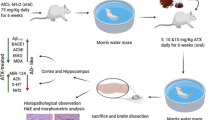Abstract
Alzheimer’s disease (AD) is one of the most common neurodegenerative diseases which seriously affect the quality of life of the elderly. Schisandrin (SCH) and nootkatone (NKT) are the two marked active components in ASHP. In this study, the effects of Alpinia oxyphylla—Schisandra chinensis herb pair (ASHP) as well as its bioactive components on cognitive deficiency and dementia were revealed via Aβ1–42-induced AD in mouse. Morris water maze test showed that acute administration of ASHP and SCH + NKT treatments had higher discrimination index in the object recognition task, more quadrant dwell time and shorter escape latency compared with those in the Morris water maze. The levels of TNF-α, IL-1β and IL-6 were decreased after ASHP and SCH + NKT treatment. The inflammatory response was attenuated by inhibiting TLR4/ NF-κB/ NLRP3 pathway. In addition, ASHP and SCH + NKT treatments significantly restored the activities of superoxide dismutase (SOD), glutathione S-transferase (GST), cyclooxygenase-2 (COX-2), total antioxidant capacity (T-AOC) and inducible nitric oxide syntheses (iNOS), and the levels of glutathione (GSH), malondialdehyde (MDA) and nitric oxide (NO). The histopathological changes of hippocampus were noticeably improved after ASHP and SCH + NKT treatments. These findings demonstrate that ASHP as well as its bioactive components exerted a protective effects on cognitive disorder, inflammatory reaction and oxidative stress.









Similar content being viewed by others
References
Antunes M, Biala G (2012) The novel object recognition memory: neurobiology, test procedure, and its modifications. Cogn Process 13:93–110
Blennow K, Leon MJD, Zetterberg H (2006) Alzheimer's disease. Lancet 368:387–403
BRYAN D, DEVAN EHG (1996) Dissociation of hippocampal and striatal contributions to spatial navigation in the water maze. Neurobiol Learn Mem 66
Butterfield, D.A., 2018. Perspectives on oxidative stress in Alzheimer's disease and predictions of future research emphases. Journal of Alzheimers Disease 1–11
Contedaban A, Ambike V, Régis Guillot, et al., (2018) A metallo pro-drug to target cu(II) in the context of Alzheimer's disease. Chemistry 24:5095–5099
D’Hooge R, Deyn PPD (2001) Applications of the Morris water maze in the study of learning and memory. Brain Res Rev 36:60–90
Di, H., et al., 2012. Schizandrin, an Antioxidant Lignan from Schisandra chinensis, Ameliorates Aβ1–42-Induced Memory Impairment in Mice. Oxidative Medicine and Cellular Longevity,2012,(2012-5-22). 2012, 721721
Dubinina EE, Pustygina AV (2007) Free radical processes in aging, neurodegenerative diseases and other pathological states. Biochemistry Supplement 1:284–298
Eslami SM, Ghasemi M, Bahremand T, Momeny M, Gholami M, Sharifzadeh M, Dehpour AR (2017) Involvement of nitrergic system in anticonvulsant effect of zolpidem in lithium-pilocarpine induced status epilepticus: evaluation of iNOS and COX-2 genes expression. Eur J Pharmacol 815:454–461
Gustaw-Rothenberg KA, Lerner A, Perry G, Siedlak SL, Zhu X, Smith MA (2010) MDA and GSH levels in newly diagnosed Alzheimer's disease patients: a population-based study. Alzheimers & Dementia the Journal of the Alzheimers Association 6:S510–S511
Halliwell B (2001) Role of free radicals in the neurodegenerative diseases. Drugs Aging 18:685–716
He B, Xu F, Xiao F, Yan T, Wu B, Bi K, Jia Y (2018) Neuroprotective effects of nootkatone from Alpiniae oxyphyllae Fructus against amyloid-β-induced cognitive impairment. Metab Brain Dis 33:251–259
Lee HG et al (2006) Amyloid-beta toxicity in Alzheimer disease: the null versus the alternate hypotheses. In: Biennial Meeting of the Asian-Pacific-Society-For-Neurochemistry, pp 12–12
Li W, Tang Y, Qian Y, Shang E, Wang L, Zhang L, Su S, Duan JA (2014) Comparative analysis of main aromatic acids and phthalides in Angelicae Sinensis Radix, chuanxiong Rhizoma, and Fo-Shou-san by a validated UHPLC-TQ-MS/MS. J Pharm Biomed Anal 99:45–50
Liao Y, Qi XL, Cao Y, Yu WF, Ravid R, Winblad B, Pei JJ, Guan ZZ (2016) Elevations in the levels of NF-κB and inflammatory chemotactic factors in the brains with Alzheimer's disease - one mechanism may involve α3 nicotinic acetylcholine receptor. Curr Alzheimer Res 13:1290–1301
Lin LF, Luo HM (2011) Screening of treatment targets for Alzheimer's disease from the molecular mechanisms of impairment by β-amyloid aggregation and tau hyperphosphorylation. Neurosci Bull 27:53–60
Liston A, Masters SL (2017) Homeostasis-altering molecular processes as mechanisms of inflammasome activation. Nat Rev Immunol 17:208–214
Malashenkova IK, Khailov NA, Krynskii SA, Ogurtsov DP, Kazanova GV, Velichkovskii BB, Selezneva ND, Fedorova YB, Ponomareva EV, Kolykhalov IV, Gavrilova SI, Didkovskii NA (2017) Levels of proinflammatory cytokines and vascular endothelial growth factor in patients with Alzheimer's disease and mild cognitive impairment. Neurosci Behav Physiol 47:694–698
Manczak M, Anekonda TS, Henson E, Park BS, Quinn J, Reddy PH (2006) Mitochondria are a direct site of Aβ accumulation in Alzheimer's disease neurons: implications for free radical generation and oxidative damage in disease progression. Hum Mol Genet 15:1437–1449
Miao J et al (2010) Clinical studies with traditional Chinese medicine in the past decade and future research and development. Planta Med 76:2048
Nuray N, Ulusu MS, Avci A, Canbolat O, Ozansoy G, Ari N, Bali M, Stefek M, Stolc S, Gajdosik A, Karasu Ç (2003) Pentose phosphate pathway, glutathione-dependent enzymes and antioxidant defense during oxidative stress in diabetic rodent brain and peripheral organs: effects of Stobadine and vitamin E. Neurochem Res 28:815–823
Ozden H, Durmaz R, Kanbak G, Uzuner K, Aral E, Kartkaya K, Kabay SC, Atasoy MA (2011) Erythropoietin prevents nitric oxide and cathepsin-mediated neuronal death in focal brain ischemia. Brain Res 1370:185–193
Phaniendra A, Jestadi DB, Periyasamy L (2015) Free radicals: properties, sources, targets, and their implication in various diseases. Indian J Clin Biochem 30:11–26
Pimplikar SW (2014) Neuroinflammation in Alzheimer's disease: from pathogenesis to a therapeutic target. J Clin Immunol 34(Suppl 1):S64
Qi Y, Cheng X, Jing H, Yan T, Xiao F, Wu B, Bi K, Jia Y (2019) Effect of Alpinia oxyphylla-Schisandra chinensis herb pair on inflammation and apoptosis in Alzheimer's disease mice model. J Ethnopharmacol 237:28–38
Qu M-H, Yang X, Wang Y, Tang Q, Han H, Wang J, Wang GD, Xue C, Gao Z (2016) Docosahexaenoic acid-phosphatidylcholine improves cognitive deficits in an Aβ23-35-induced Alzheimer’s disease rat model. Curr Top Med Chem 16:558–564
Rahimifard M, Maqbool F, Moeini-Nodeh S, Niaz K, Abdollahi M, Braidy N, Nabavi SM, Nabavi SF (2017) Targeting the TLR4 signaling pathway by polyphenols: a novel therapeutic strategy for neuroinflammation. Ageing Res Rev 36:11–19
Richardson JS (2010) Free radicals in the genesis of Alzheimer's disease. Ann N Y Acad Sci 695:73–76
Sakthivel KM, Guruvayoorappan C (2015) Acacia ferruginea inhibits inflammation by regulating inflammatory iNOS and COX-2. J Immunotoxicol 13:127–135
Sha T, Iizawa Y, Ii M (2011) Combination of imipenem and TAK-242, a toll-like receptor 4 signal transduction inhibitor, improves survival in a murine model of polymicrobial sepsis. Shock. 35:205–209
Shi Q, Gibson GE (2007) Oxidative stress and transcriptional regulation in Alzheimer disease. Alzheimer Dis Assoc Disord 21:276–291
Shi SH, Zhao X, Liu AJ, Liu B, Li H, Wu B, Bi KS, Jia Y (2015) Protective effect of n-butanol extract from Alpinia oxyphylla on learning and memory impairments. Physiol Behav 139:13–20
Shi ZM, Han YW, Han XH, Zhang K, Chang YN, Hu ZM, Qi HX, Ting C, Zhen Z, Hong W (2016) Upstream regulators and downstream effectors of NF-kappaB in Alzheimer's disease. J Neurol Sci 366:127–134
Sil S, Ghosh T (2016a) Role of cox-2 mediated neuroinflammation on the neurodegeneration and cognitive impairments in colchicine induced rat model of Alzheimer's disease. J Neuroimmunol 291:115–124
Sil S, Ghosh T (2016b) Cox-2 plays a vital role in the impaired anxiety like behavior in colchicine induced rat model of Alzheimer disease. Behav Neurol 2016:1501527
Sohal RS (2002) Role of oxidative stress and protein oxidation in the aging process. Free Radic Biol Med 33:37–44
Song JX et al (2015) Protective effects of dibenzocyclooctadiene lignans from Schisandra chinensis against beta-amyloid and homocysteine neurotoxicity in PC12 cells. Phytother Res 25:435–443
Sosa-Ortiz AL, Acosta-Castillo I, Prince MJ (2012) Epidemiology of dementias and Alzheimer’s disease. Arch Med Res 43:600–608
Tang SS, Hong H, Chen L, Mei ZL, Ji MJ, Xiang GQ, Li N, Ji H (2014) Involvement of cysteinyl leukotriene receptor 1 in Aβ1–42-induced neurotoxicity in vitro and in vivo. Neurobiol Aging 35:590–599
Tönnies E, Trushina E (2017) Oxidative stress, synaptic dysfunction, and Alzheimer's disease. Journal of Alzheimers Disease Jad. 57:1105–1121
Vorhees CV, Williams MT (2006) Morris water maze: procedures for assessing spatial and related forms of learning and memory. Nat Protoc 1:848–858
Wang S, Hu Y, Tan W, Wu X, Chen R, Cao J, Chen M, Wang Y (2012) Compatibility art of traditional Chinese medicine: from the perspective of herb pairs. J Ethnopharmacol 143:412–423
Wang Y, Wang M, Xu M, Li T, Fan K, Yan T, Xiao F, Bi K, Jia Y (2018) Nootkatone, a neuroprotective agent from Alpiniae Oxyphyllae Fructus, improves cognitive impairment in lipopolysaccharide-induced mouse model of Alzheimer's disease. Int Immunopharmacol 62:77–85
Wei B, Liu MY, Chen ZX, Wei MJ (2018) Schisandrin ameliorates cognitive impairment and attenuates Aβ deposition in APP/PS1 transgenic mice: involvement of adjusting neurotransmitters and their metabolite changes in the brain. Acta Pharmacol Sin 39:616–625
Xu Z et al (2016) Total Lignans of Schisandra chinensis ameliorates Aβ1-42-induced neurodegeneration with cognitive impairment in mice and primary mouse neuronal cells. PLoS One 11:e0152772
Youn H, Ji I, Ji HP, Markesbery WR, Ji TH (2007) Under-expression of Kalirin-7 increases iNOS activity in cultured cells and correlates to elevated iNOS activity in Alzheimer's disease hippocampus. Journal of Alzheimers Disease Jad 12:271–281
Zhang GX et al (2013) [the role of TLR4-mediated MyD88-dependent pathway in neuroinflammation in hippocampal neurons of rats]. Chinese. J Appl Physiol 29:42
Acknowledgements
This study was supported by the National Natural Science Foundation of China (no. 81573580). Key laboratory of polysaccharide bioactivity evaluation of TCM of Liaoning Province. Key techniques study of consistency evaluation of drug quality and therapeutic effect (18-400-4-08) and Liaoning Distinguished Professor Project for Ying Jia (2017).
Author information
Authors and Affiliations
Corresponding authors
Ethics declarations
Conflict of interest
The authors have no conflict of interest to declare.
Additional information
Publisher’s note
Springer Nature remains neutral with regard to jurisdictional claims in published maps and institutional affiliations.
Rights and permissions
About this article
Cite this article
Qi, Y., Cheng, X., Jing, H. et al. Combination of schisandrin and nootkatone exerts neuroprotective effect in Alzheimer’s disease mice model. Metab Brain Dis 34, 1689–1703 (2019). https://doi.org/10.1007/s11011-019-00475-4
Received:
Accepted:
Published:
Issue Date:
DOI: https://doi.org/10.1007/s11011-019-00475-4




